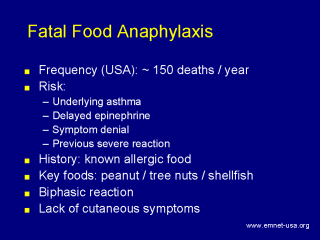 |
It is estimated
that about 100-200 individuals in the US die each year from food-allergic
reactions. Based on a few reports, individuals at increased risk for fatal
anaphylaxis include those who delay treatment with epinephrine, have asthma,
have experienced prior severe food allergic reactions, or who deny ongoing
symptoms. Teenagers appear to be at particular risk. Usually these deaths
are caused by a known food allergy while away from home and the fatal flaw
is the failure to promptly administer epinephrine. Many of the children
reported with fatal reactions had a biphasic reaction. They had initial mild
symptoms within 30 minutes of ingesting the food that resolved only to have
a recurrence of severe symptoms 1-2 hours following the ingestion. Thus, it
is vitally important to observe patients with an acute anaphylactic reaction
for at least 4 hours prior to discharge from the emergency room.
Additionally, fifteen percent of those with severe reactions and 80% with
fatal reactions had no skin symptoms. Thus, the absence of skin symptoms
does not exclude the possibility of anaphylaxis. |
